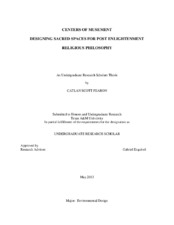| dc.description.abstract | Due to vast changes in religious thinking, an attempt to rethink, and ultimately explode and recreate, religious typology in architecture as it exists becomes necessary. An intense review on existential and pragmatic religious literature leads to the conclusion that the subject of sacred architecture has changed, creating a need to develop a new typology. After arguing the justification of this rethinking, the paper examines literature regarding religious typology as it currently exists and its relationship to the city, the idea of monument and its appropriateness for religious architecture, and the relationship between shared memory and sacred spaces. Finally, the ideas gleaned are applied to three distinct urban fabrics in an attempt to further analyze the theoretical space and produce prototypical models for the fabrics addressed. From these studies an archetypal model of an ideal sacred architecture is created for all three urban conditions. | en |


